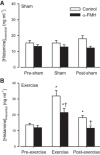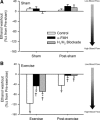Mast cell degranulation and de novo histamine formation contribute to sustained postexercise vasodilation in humans
- PMID: 27562843
- PMCID: PMC5401950
- DOI: 10.1152/japplphysiol.00633.2016
Mast cell degranulation and de novo histamine formation contribute to sustained postexercise vasodilation in humans
Abstract
In humans, acute aerobic exercise elicits a sustained postexercise vasodilation within previously active skeletal muscle. This response is dependent on activation of histamine H1 and H2 receptors, but the source of intramuscular histamine remains unclear. We tested the hypothesis that interstitial histamine in skeletal muscle would be increased with exercise and would be dependent on de novo formation via the inducible enzyme histidine decarboxylase and/or mast cell degranulation. Subjects performed 1 h of unilateral dynamic knee-extension exercise or sham (seated rest). We measured the interstitial histamine concentration and local blood flow (ethanol washout) via skeletal muscle microdialysis of the vastus lateralis. In some probes, we infused either α-fluoromethylhistidine hydrochloride (α-FMH), a potent inhibitor of histidine decarboxylase, or histamine H1/H2-receptor blockers. We also measured interstitial tryptase concentrations, a biomarker of mast cell degranulation. Compared with preexercise, histamine was increased after exercise by a change (Δ) of 4.2 ± 1.8 ng/ml (P < 0.05), but not when α-FMH was administered (Δ-0.3 ± 1.3 ng/ml, P = 0.9). Likewise, local blood flow after exercise was reduced to preexercise levels by both α-FMH and H1/H2 blockade. In addition, tryptase was elevated during exercise by Δ6.8 ± 1.1 ng/ml (P < 0.05). Taken together, these data suggest that interstitial histamine in skeletal muscle increases with exercise and results from both de novo formation and mast cell degranulation. This suggests that exercise produces an anaphylactoid signal, which affects recovery, and may influence skeletal muscle blood flow during exercise.NEW & NOTEWORTHY Blood flow to previously active skeletal muscle remains elevated following an acute bout of aerobic exercise and is dependent on activation of histamine H1 and H2 receptors. The intramuscular source of histamine that drives this response to exercise has not been identified. Using intramuscular microdialysis in exercising humans, we show both mast cell degranulation and formation of histamine by histidine decarboxylase contributes to the histamine-mediated vasodilation that occurs following a bout of aerobic exercise.
Keywords: extracellular fluid; histamine; microdialysis; postexercise hypotension; regional blood flow.
Copyright © 2017 the American Physiological Society.
Figures





References
-
- Ayada K, Watanabe M, Endo Y. Elevation of histidine decarboxylase activity in skeletal muscles and stomach in mice by stress and exercise. Am J Physiol Regul Integr Comp Physiol 279: R2042–R2047, 2000. - PubMed
Publication types
MeSH terms
Substances
Grants and funding
LinkOut - more resources
Full Text Sources
Other Literature Sources
Medical

